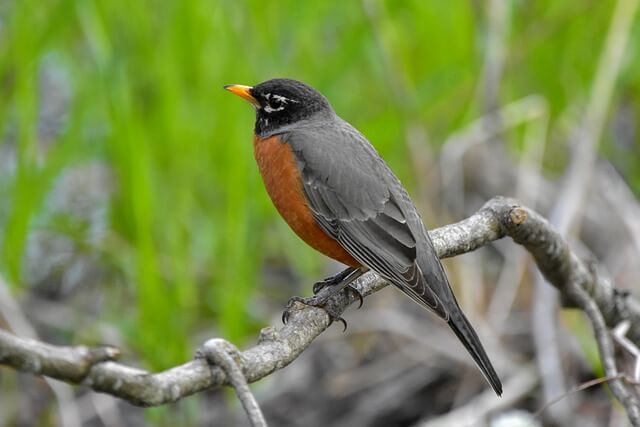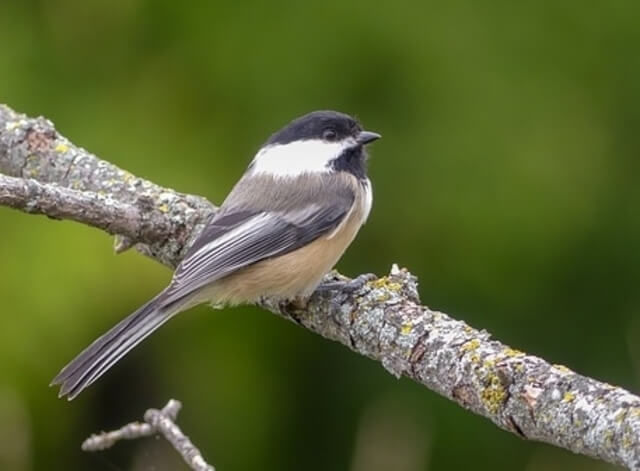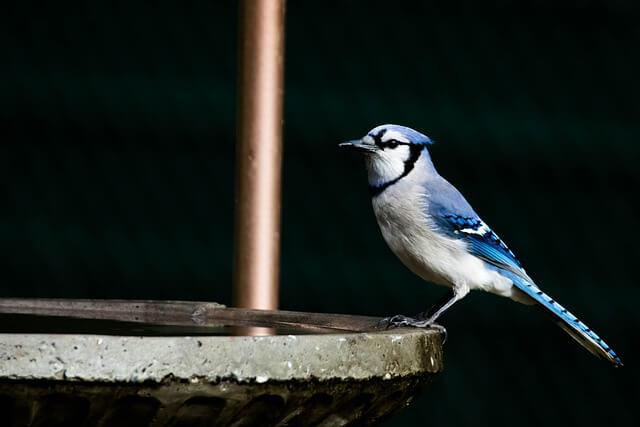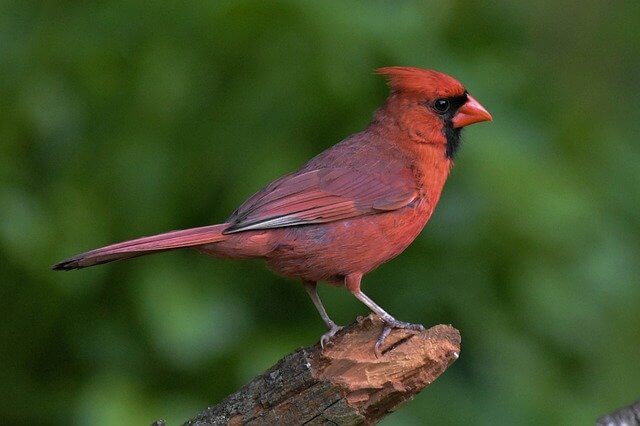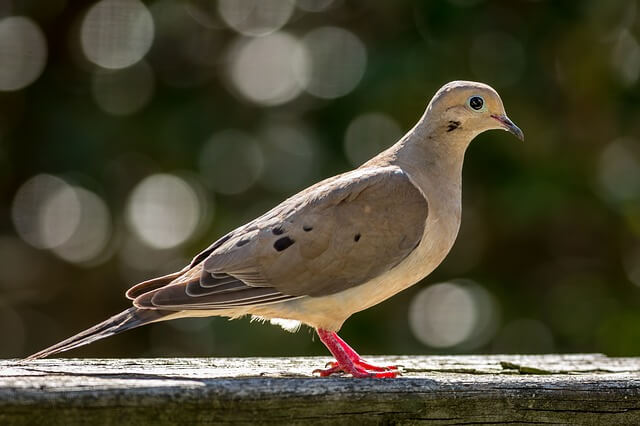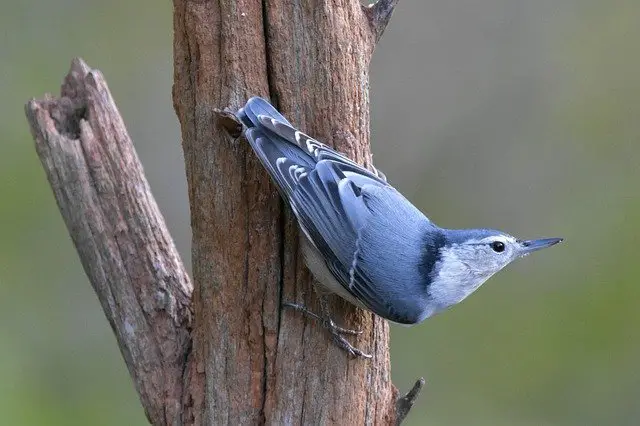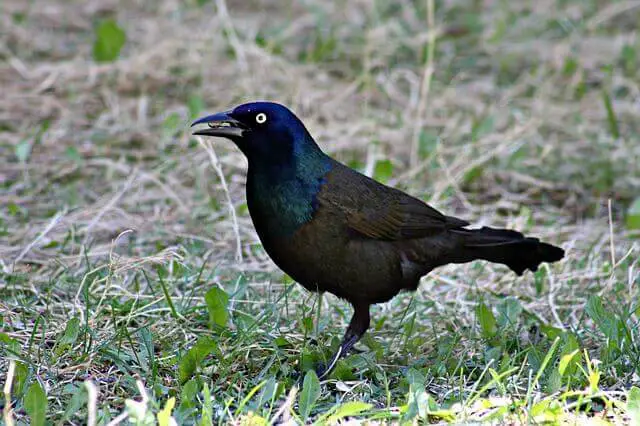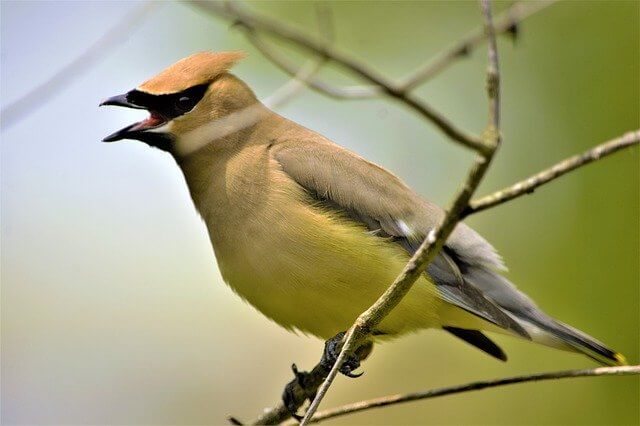Embark on a journey through Michigan’s diverse landscapes with our ultimate guide to the 40 most common backyard bird species! From the charming American Goldfinch to the vibrant Northern Cardinal, Michigan’s forests, lakes, and urban areas host a rich tapestry of avian life.
In this comprehensive guide, we’ll uncover the unique characteristics, habitats, and behaviors of each species, offering valuable insights for bird enthusiasts and nature lovers alike.
Table of Contents
- 1 Most Common Birds in Michigan
- 1.1 American Robin
- 1.2 Black-capped Chickadee
- 1.3 Blue Jay
- 1.4 Northern Cardinal
- 1.5 Mourning Dove
- 1.6 American Crow
- 1.7 American Goldfinch
- 1.8 Downy Woodpecker
- 1.9 White-breasted Nuthatch
- 1.10 Song Sparrow
- 1.11 Red-bellied Woodpecker
- 1.12 European Starling
- 1.13 Tufted Titmouse
- 1.14 House Sparrow
- 1.15 Common Grackle
- 1.16 Cedar Waxwing
- 2 Frequently Asked Questions
- 3 Author
Most Common Birds in Michigan
American Robin
American Robins are native to North America and are a common sight during the summer months. They can be found in forested areas, grasslands, meadows, farms and cities. Their diet consists mainly of insects, worms, seeds and berries, but they will also eat birds eggs if given the opportunity.
These small songbirds migrate south for the winter to escape colder temperatures, but some individuals stay behind in northern regions to help spread out populations, so there’s less chance of them becoming extinct.
- Color: Mostly brown on the back with an orange-colored breast, yellow bill
- Habitat: Wooded areas, backyards, parks, fields
- Range: USA, Canada, Mexico
- Size: 12 – 16″ inches in length
- Weight: 72 – 95 grams
- Diet: Fruits, berries, and insects (earthworms, beetles, caterpillars etc.)
- Family: Turdidae
- Genus: Turdus
Related Post: Interesting American Robin Fun Facts
Black-capped Chickadee
The black-capped chickadee is a small, well-known bird found in North America. This particular species of bird can be identified by its black cap and bib on the chest, as well as white cheeks and throat. These birds live year round in the United States, but migrate to Mexico during winter months.
They also make use of different habitats throughout the year: feeding on insects and berries in summer, while feasting on acorns or seeds when they’re available. Most of the Black-capped Chickadees that are in Michigan are found on the south coast, and you can find some in the northern part of the state as well.
- Color: A black cap, white on face, white/reddish-brown flanks
- Habitat: Deciduous and mixed forests, backyards, parks
- Range: USA and Canada
- Size: 11.5 -16 cm length
- Weight: 8 – 15 grams
- Diet: Insects, seeds, berries
- Family: Paridae
- Genus: Poecile
Related Posts:
Blue Jay
Blue Jays are one of the most recognizable birds in North America. They can be found throughout Canada and parts of the United States, even as far south as Mexico. Blue Jays have a wide range of habitats they inhabit, from woodlands to coniferous forests, deciduous forests, orchards, farms and residential areas.
Blue Jays can also live in places that offer them protection from predators, such as caves or treetops. These birds are omnivores, meaning they eat both meat and plants for food sources. Blue Jays eat nuts, seeds, berries, eggs and insects.
- Color: Blue crest on the head, wings, back, and tail, and has a white face and belly
- Habitat: Deciduous and mixed forests, mixed woodlands, backyards, parks
- Range: Southern Canada, Eastern and Central United States, Florida and Texas
- Size: 8 – 12″ inches
- Weight: 70 – 100 grams
- Diet: Nuts, seeds, caterpillars, grasshoppers, and beetles
- Family: Corvidae
- Genus: Cyanocitta
Related Post :
- How to Attract Blue Jays to your Yard?
- Do Blue Jays Migrate? The Truth
- What do Blue Jay Eat – All The Facts
Northern Cardinal
The Northern Cardinal is a very common bird found in the eastern United States. The range of this species spans from Minnesota to Virginia, and its habitat can vary from swamps, deciduous forests, or dense shrubs to woodlands. T
These birds typically feed on insects and seeds, but will also eat berries or other fruit if it is available. They are not migratory, but they do move around during the winter months depending on where food sources are located at that time of year.
- Color: Mostly red throughout, with a black mask on the face
- Habitat: woodlands, gardens, parks, backyards, and wetlands
- Range: USA, Canada, Mexico
- Size: 8.2 – 9.3″ inches
- Weight: 33 – 65 grams
- Diet: Fruits, berries, and insects (grasshoppers, beetles, snails, cicadas)
- Family: Cardinalidae
- Genus: Cardinalis
Related Posts
Mourning Dove
The mourning dove is a small bird found in North America. They are mostly found in eastern and central regions of the United States, but can also be seen as far west as California. Mourning doves inhabit grasslands, croplands, forest edges and other open areas with dense low vegetation or trees nearby for roosting.
Their diet consists mainly of seeds from plants such as grains, corn and oats. They eat these plants during both summer months when they are abundant and winter months. You can see this bird in various places in Michigan.
- Color: Light gray-brown and lighter and pinkish below. The wings have black spots, small dark bill.
- Habitat: Open habitats, urban areas, farms, prairie, grassland, wooded area
- Range: USA, Canada, Mexico, Central America, Greater Antilles
- Size: 12″ inches length
- Weight: 112 – 170 grams
- Diet: Rapeseed, corn, millet, safflower, sunflower seeds, pokeberry, sesame, and wheat.
- Family: Columbidae
- Genus: Zenaida
Related Posts: 10 Facts about Mourning Doves
American Crow
The American Crow is a large, all-black bird found in North America. They range from southern Canada to the northern reaches of Mexico and as far west as California. Crows live in every habitat from tundra to desert and inhabit many human-made environments such as city parks, farmland, suburbs, and backyards.
Their diet consists mainly of insects and small animals they find on the ground or scavenge for food, along with fruit, nuts, seeds and other plant material.
- Color: Black
- Habitat: Open country, farms, parks, woodlands, towns, cities
- Range: Canada, USA, Mexico
- Size: 16 – 21″ inches in length
- Weight: 315 -620 grams
- Diet: invertebrates, carrion, seeds, eggs fish, grains, mice, frogs, and other small animals.
- Family: Corvidae
- Genus: Corvis
Related Posts:
American Goldfinch
The American Goldfinch is a small songbird in the finch family. It breeds throughout most of North America, and as far south as northern South America. They are most commonly found east of the Rocky Mountains, where they have access to food year round.
This species lives primarily on seeds from weeds, grasses, thistles and plants like fruit-bearing bushes and vines, as well as insects and their larvae. In winter, they sometimes gather in large flocks to feed on thistle seed heads or may visit feeders with black sunflower seeds, millet spray or safflower seed.
- Color: Face, neck, and underside are yellow, black wings with white bars
- Habitat: Deciduous conifers, and forests, thickets, gardens, roadside, grasslands, meadows
- Range: Canada, USA, and Mexico
- Size: 4.3 – 5.5″ inches length
- Weight: 12 -18 grams
- Diet: Grass, dandelions, chickweed, sunflowers and ragweed, thistle, red alder, birch, spruce seeds
- Family: Carduelinae
- Genus: Spinus
Related Post: American Goldfinch Interesting Facts
Downy Woodpecker
Downy Woodpeckers range from southern Canada to the southeastern United States. They live in deciduous forests, woodland edges and mixed woodlands. The birds usually nest around trees with exposed sapwood or cambium, but they will also use abandoned nests made by other animals like squirrels or owls.
Downy Woodpeckers eat insects like beetles and ants, which they find on trees by pecking at them with their long bills. During migration season, they fly southward from late September through November to avoid freezing temperatures in northern regions.
- Color: Black with a white throat, belly, and back. White spots on wings
- Habitat: Deciduous forests and thickets, roadside, grasslands, backyards, parks
- Range: Canada, USA, and Mexico
- Size: 5.5 – 7.1″ inches in length
- Weight: 20 – 33 grams
- Diet: East mostly insects such as ants, beetles, gall wasps, and caterpillars
- Family: Picidae
- Genus: Dryobates
Related Post: How to Attract Downy Woodpeckers: Expert Tips!
White-breasted Nuthatch
The White-Breasted Nuthatch is a small songbird that breeds in North America. They are found across the continent, though their range spans from Alaska to Newfoundland and southern Canada to Mexico. The bird’s habitat includes mixed forests with dense understory, such as pine or oak woods, and deciduous forest types such as beech-maple forest or floodplain forest.
The nuthatches feed on insects such as ants, beetles, caterpillars and other invertebrates; they also eat some seeds from cones of pines or fruit.
- Color: A white face, flanks, and chest. It has a black cap on its head a bluish-gray upper and a brown lower belly
- Habitat: Deciduous forests, conifers, roadside, rivers, backyards, parks
- Range: Southern Canada, USA
- Size: 5.9″ inches in length
- Weight: 20 grams
- Diet: Acorn nuts, hickory nuts, ants, caterpillars, scale insects, pine weevils
- Family: Sittidae
- Genus: Sitta
Related Post: How to Attract Nuthatches to your Backyard?
Song Sparrow
The song sparrow is a small bird that can be found in North America. They are often seen in fields, meadows and around ponds where they are picking up seeds from the ground.
These birds also feed on insects, snails and worms as well as berries, which provide them with nutrients needed for survival. They migrate seasonally from their summer habitats (Northern Hemisphere) to winter habitats (Southern Hemisphere).
- Color: Brown with white belly, white cheek,
- Habitat: Urban centers, farms, backyards, edges, yards, and parks
- Range: Europe, Mediterranean, Asia, Australasia, Africa, and the Americas
- Size: 5.5 – 7.0″ inches
- Weight: 25 – 40 grams
- Diet: Grains, seeds, and insects
- Family: Passeridae
- Genus: Passer
Related Post: How to Attract Sparrows to your Backyard
Red-bellied Woodpecker
The red-bellied woodpecker is a medium-sized bird that has a black and white striped back. They are found in North America and the eastern half of South America. Their habitat ranges from forests to open areas with trees, such as parks or farmlands. The red-bellied woodpecker feeds on insects, small animals, fruit and nuts.
It also feeds on sap from tree trunks, which they get by pecking at them for hours every day to feed their appetite for food. They migrate south for the winter, but not too far south; they often stop off at bird feeders along their migration route as a source of food and water.
- Color: Gray on body and face and underparts. Black and white pattern on wings, back, and tail.
- Habitat: Forests, backyards
- Range: Southern Canada, Eastern United States, Florida
- Size: 9 – 10.6″ inches long
- Weight: 56 -91 grams
- Diet: Insects, small fish, oozing sap, tree frogs, and eggs of small birds.
- Family: Picidae
- Genus: Melanerpes
Related Post: How to Attract Red-bellied Woodpeckers to your Yard?
European Starling
The European Starling is a small, compact bird with a distinctive plumage that has an iridescent sheen. They are often found in parks, yards, gardens and around trees.
The birds have a broad range of habitats that they occupy across the United States but prefer to live near human settlements due to their omnivorous diet which includes insects as well as grains and seeds from lawns, crops or other food sources close by.
- Color: Black with glossy green and purple iridescence plumage, yellow beak.
- Habitat: Forests, woodlands, backyards, edges, yards, and parks
- Range: North America, Europe, Africa, India, China, Middle East.
- Size: 7 – 9″ inches long
- Weight: 60 – 100 grams
- Diet: Insects (ants, beetles, invertebrates), fruits, seeds, berries
- Family: Picidae
- Genus: Colaptes
Related Posts: How To Attract European Starlings To Your Yard Fast?
Tufted Titmouse
The Tufted Titmouse is a medium-sized songbird that lives in deciduous and mixed forests, typically close to water. They are migratory birds that travel from their summer breeding grounds to the wintering range in Texas and Mexico, as well as the Gulf Coast of Florida.
Their diet consists mainly of insects during the summer months when they’re living at their breeding ground, but shifts to berries during migration season and wintertime.
- Color: Gray upper, white front, a tufted gray crest on the head
- Habitat: Deciduous forests, river basin, backyards, swamps
- Range: Canada, USA, and Mexico
- Size: 5.5 – 6.4″ inches
- Weight: 18 – 26 grams
- Diet: Nuts, insects, berries, seeds small fruit, and snails
- Family: Paridae
- Genus: Baeolophus
Related Post: How to Attract Tufted Titmouse to my Yard?
House Sparrow
House Sparrows are a species of bird that has the widest range of any other North American songbird. They can be found in every continent except Antarctica and have been seen as far north as the Arctic Circle, and south to Tierra del Fuego, Argentina. They live in woodlands, grasslands and marshes, as well as human-made habitats such as parks and gardens.
House Sparrows eat mainly insects and berries, but also hunt other invertebrates such as spiders or snails. They can be found from coast to coast throughout North America, except for the southeast coastal region of Texas. The song sparrow is a very common bird that lives in many environments.
- Color: Gray head marking, a reddish-brown back, and gray underparts
- Habitat: Urban centers, Rural, suburban areas, gardens, edges, and parks
- Range: North America, Central America, South America, Africa, Australia, New Zealand
- Size: 5.5 – 7.1″ inches in length
- Weight: 25 – 39 grams
- Diet: Insects, beetles, caterpillars, aphids,, grasshoppers, crustaceans, earthworms, vertebrates
- Family: Passeridea
- Genus: Passer
Related Post: How to Attract Sparrows to your Backyard
Common Grackle
The common grackle is a blackbird that lives in North America. They are found in the east coast, central United States and west coast of the US. This species lives in open habitats including wetlands, fields, orchards and gardens where they eat mainly insects, earthworms, berries and seeds.
In migration season they travel south to warmer climates for winter where they can find food easier than during colder months when their favorite prey may be scarce.
- Color: Black overall with a blue, and purple iridescence.
- Habitat: Woodlands, marshes, meadows, parks, backyards, and fields
- Range: East of the Canadian Rockies, Canada, and the United States
- Size: 11 – 13″ inches length
- Weight: 75 – 143 grams
- Diet: minnows, eggs, berries, seeds, grain, insects, frogs, mice
- Family: Icteridae
- Genus: Quiscalus
Cedar Waxwing
Cedar Waxwings are a species of birds found in North America. They have a limited range, with the majority residing from Canada to Mexico. They have a range of all but the Northernmost states and their habitat includes open woodlands, meadows, gardens, parks and city streets., but they prefer warmer climates during winter months for breeding purposes.
The Cedar Waxwing’s diet consists mainly of fruit such as berries and apples; they also eat insects when other food sources are scarce. Cedar Waxwings migrate to southern states during winter due to their inability to withstand cold temperatures. They migrate to Central America for winter from August through October.
Related Post: How to Attract Cedar Waxwings to your yard
More Birds Just Added (Updated)
- Northern Flicker
- House Finch
- Dark-eyed Junco
- Hairy Woodpecker
- Gray Catbird
- Brown-headed Cowbird
- Tree Swallow
- Chipping Sparrow
- Cedar Waxwing
- Barn Swallow
- Common Yellowthroat
- Eastern Bluebird
- Yellow Warbler
- Baltimore Oriole
- Red-breasted Nuthatch
- Rose-breasted Grosbeak
- House Wren
- Red-eyed Vireo
- Yellow-rumped Warbler
- American Tree Sparrow
- Eastern Phoebe
- Eastern Wood-Pewee
- Eastern Kingbird
- Pileated Woodpecker
Frequently Asked Questions
What is the rarest bird in Michigan?
There are 450 bird species in Michigan, and many of them are common. But there is one rarer than all the rest: Virginia’s Warbler. It has a 0.0001% frequency of occurrence, which means that on average, only one bird per year will be seen at any given location.
What is the most common bird?
The American Robin is the most common bird in Michigan, with a frequency of 43%. They can be found throughout the state and are often found nesting near human populations, making them easy to spot.
What is the biggest bird in Michigan?
Sandhill Cranes are the largest bird in Michigan. The males are four feet tall, and have a wingspan of up to five feet and can weigh up to fifteen pounds. They live mostly on grasslands, but also eat small animals like mice, rats, and other birds.
What is the biggest Hawk in Michigan?
The Ferruginous Hawk is the biggest hawk in Michigan. It measures two feet in length, with a wingspan of over 4.5 feet. It lives in wetlands and other wet habitats, eating mostly small mammals such as mice and voles.
Are Orioles rare in Michigan?
The orioles live in Eastern parts of the US but don’t seem to be too common here in Michigan which leads some people to believe they may be rare.


